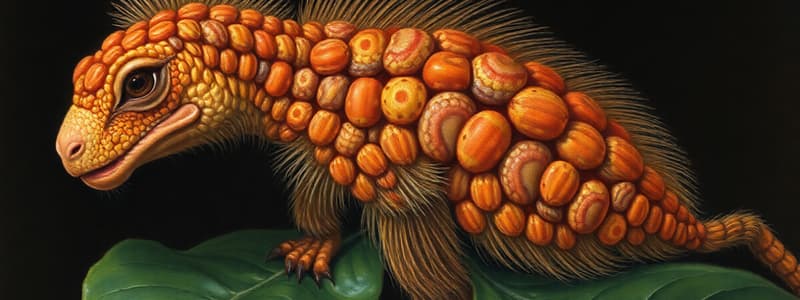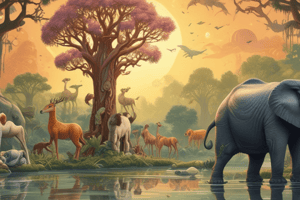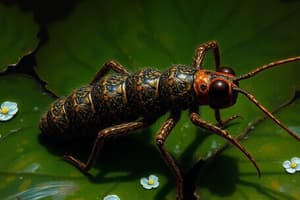Podcast
Questions and Answers
Which of these germ layers forms the external covering (skin) and nervous system?
Which of these germ layers forms the external covering (skin) and nervous system?
- Ectoderm (correct)
- Blastoderm
- Endoderm
- Mesoderm
What is a key difference in embryonic development between protostomes and deuterostomes?
What is a key difference in embryonic development between protostomes and deuterostomes?
- Protostomes have indeterminate cell fate, while deuterostomes have determinate cell fate
- Protostomes develop a coelom through schizocoely, while deuterostomes develop a coelom through enterocoely.
- Protostomes have radial cleavage, while deuterostomes have spiral cleavage.
- Protostomes develop a mouth from the blastopore, while deuterostomes develop an anus from the blastopore. (correct)
What is the primary function of the mesoderm in triploblastic animals?
What is the primary function of the mesoderm in triploblastic animals?
- Forms the nervous system.
- Forms the muscles and skeleton. (correct)
- Forms the external covering.
- Forms the digestive tract lining.
Which of the following is a characteristic of animals with radial symmetry?
Which of the following is a characteristic of animals with radial symmetry?
What is the correct order of the germ layers from outermost to innermost?
What is the correct order of the germ layers from outermost to innermost?
Which of these is an example of a pseudocoelomate animal?
Which of these is an example of a pseudocoelomate animal?
What is the primary advantage of segmentation in animals?
What is the primary advantage of segmentation in animals?
Which of the following statements accurately describes homeostasis?
Which of the following statements accurately describes homeostasis?
What is the definition of a homeotherm?
What is the definition of a homeotherm?
Which of the following is NOT a mechanism of homeostasis?
Which of the following is NOT a mechanism of homeostasis?
Which type of feedback loop is used to maintain a stable body temperature?
Which type of feedback loop is used to maintain a stable body temperature?
What is the primary function of the hypothalamus in thermoregulation?
What is the primary function of the hypothalamus in thermoregulation?
What is the main advantage of homeostasis?
What is the main advantage of homeostasis?
How does an endotherm maintain its body temperature when the environment gets colder?
How does an endotherm maintain its body temperature when the environment gets colder?
How does thermal acclimatization benefit an organism?
How does thermal acclimatization benefit an organism?
Which of the following is NOT a key factor in thermoregulation for ectotherms?
Which of the following is NOT a key factor in thermoregulation for ectotherms?
What is the difference between a homeotherm and a heterotherm?
What is the difference between a homeotherm and a heterotherm?
What is vasoconstriction and how does it contribute to thermoregulation?
What is vasoconstriction and how does it contribute to thermoregulation?
Which of the following is an example of a feedforward regulation mechanism?
Which of the following is an example of a feedforward regulation mechanism?
How does torpor differ from normal thermoregulation?
How does torpor differ from normal thermoregulation?
Which of the following is an example of an ectotherm?
Which of the following is an example of an ectotherm?
What is the physiological mechanism behind vasodilation in thermoregulation?
What is the physiological mechanism behind vasodilation in thermoregulation?
Which of these conditions would most likely lead to an increase in core body temperature?
Which of these conditions would most likely lead to an increase in core body temperature?
A lizard basking in the sun to regulate its body temperature is an example of...
A lizard basking in the sun to regulate its body temperature is an example of...
What is the primary function of the ossicles (malleus, incus, and stapes) in the middle ear?
What is the primary function of the ossicles (malleus, incus, and stapes) in the middle ear?
How do retinal photoreceptors known as rods primarily function?
How do retinal photoreceptors known as rods primarily function?
What is the role of the iris in the human eye?
What is the role of the iris in the human eye?
Which structures are part of the inner ear responsible for balance and orientation?
Which structures are part of the inner ear responsible for balance and orientation?
What is the process of accommodation in the eye?
What is the process of accommodation in the eye?
What type of receptors are involved in detecting taste and smell?
What type of receptors are involved in detecting taste and smell?
Which type of visual photoreceptor is responsible for color vision in humans?
Which type of visual photoreceptor is responsible for color vision in humans?
What do hair cells in the Organ of Corti do in response to sound vibrations?
What do hair cells in the Organ of Corti do in response to sound vibrations?
What is the primary function of adipose tissue?
What is the primary function of adipose tissue?
Which type of muscle tissue is responsible for forming the heart?
Which type of muscle tissue is responsible for forming the heart?
What role do glial cells play in the nervous system?
What role do glial cells play in the nervous system?
Which of the following organ systems is primarily responsible for substance transport?
Which of the following organ systems is primarily responsible for substance transport?
What is the primary function of neurons?
What is the primary function of neurons?
Which type of connective tissue has the function of providing strength and elasticity?
Which type of connective tissue has the function of providing strength and elasticity?
What type of signaling is characteristic of endocrine glands?
What type of signaling is characteristic of endocrine glands?
What is the role of afferent neurons?
What is the role of afferent neurons?
What is the primary function of epithelial tissue?
What is the primary function of epithelial tissue?
Which of the following is NOT a type of connective tissue?
Which of the following is NOT a type of connective tissue?
What distinguishes cardiac muscle tissue from skeletal muscle tissue?
What distinguishes cardiac muscle tissue from skeletal muscle tissue?
What is the primary function of glial cells in the nervous system?
What is the primary function of glial cells in the nervous system?
How are organs defined in the organization of the animal body?
How are organs defined in the organization of the animal body?
Which type of epithelial tissue is primarily responsible for diffusion?
Which type of epithelial tissue is primarily responsible for diffusion?
What roles do tissues play in the organization of the animal body?
What roles do tissues play in the organization of the animal body?
Which of the following statements about muscle tissues is true?
Which of the following statements about muscle tissues is true?
Flashcards
Deuterostomes
Deuterostomes
Animals where anus develops first, mouth forms later.
Protostomes
Protostomes
Animals where mouth develops from the blastopore first.
Germ Layers
Germ Layers
Layers from which all body structures develop: ectoderm, mesoderm, endoderm.
Ectoderm
Ectoderm
Signup and view all the flashcards
Mesoderm
Mesoderm
Signup and view all the flashcards
Endoderm
Endoderm
Signup and view all the flashcards
Body Cavity
Body Cavity
Signup and view all the flashcards
Homeostasis
Homeostasis
Signup and view all the flashcards
Thermoregulation
Thermoregulation
Signup and view all the flashcards
Ectotherms
Ectotherms
Signup and view all the flashcards
Endotherms
Endotherms
Signup and view all the flashcards
Thermal Acclimatization
Thermal Acclimatization
Signup and view all the flashcards
Hypothalamus
Hypothalamus
Signup and view all the flashcards
Vasoconstriction
Vasoconstriction
Signup and view all the flashcards
Vasodilation
Vasodilation
Signup and view all the flashcards
Torpor
Torpor
Signup and view all the flashcards
Cells
Cells
Signup and view all the flashcards
Tissues
Tissues
Signup and view all the flashcards
Organs
Organs
Signup and view all the flashcards
Organ systems
Organ systems
Signup and view all the flashcards
Epithelial tissue
Epithelial tissue
Signup and view all the flashcards
Connective tissue
Connective tissue
Signup and view all the flashcards
Muscle tissue
Muscle tissue
Signup and view all the flashcards
Nervous tissue
Nervous tissue
Signup and view all the flashcards
Cartilage
Cartilage
Signup and view all the flashcards
Adipose tissue
Adipose tissue
Signup and view all the flashcards
Fibrous Connective Tissue
Fibrous Connective Tissue
Signup and view all the flashcards
Neuron
Neuron
Signup and view all the flashcards
Skeletal Muscle
Skeletal Muscle
Signup and view all the flashcards
Cardiac Muscle
Cardiac Muscle
Signup and view all the flashcards
Exocrine Glands
Exocrine Glands
Signup and view all the flashcards
Glial Cells
Glial Cells
Signup and view all the flashcards
Middle Ear
Middle Ear
Signup and view all the flashcards
Accommodation
Accommodation
Signup and view all the flashcards
Rods
Rods
Signup and view all the flashcards
Cones
Cones
Signup and view all the flashcards
Cochlea
Cochlea
Signup and view all the flashcards
Chemoreceptors
Chemoreceptors
Signup and view all the flashcards
Organ of Corti
Organ of Corti
Signup and view all the flashcards
Action Potential (AP)
Action Potential (AP)
Signup and view all the flashcards
Negative Feedback
Negative Feedback
Signup and view all the flashcards
Positive Feedback
Positive Feedback
Signup and view all the flashcards
Feedforward
Feedforward
Signup and view all the flashcards
Homeotherm
Homeotherm
Signup and view all the flashcards
Heterotherm
Heterotherm
Signup and view all the flashcards
Study Notes
General Concepts
- Animal = non-human animals; all members of the animalia kingdom
- Animals are multicellular eukaryotes (lack cell walls)
- Animals are heterotrophs; they obtain energy by consuming other organisms.
- Animals are motile; they can move on their own.
- Animals have sexual or asexual reproduction.
- Animals have nerves and muscles
- Animal diversity is driven by diverse species, habitats, and characteristics.
Animal Origins
- The common ancestor of all animals (kingdom animalia) is a colonial flagellated protist from the Precambrian.
- Similarity to modern colonial flagellated species provides evidence.
- Morphological and molecular evidence supports this common ancestry.
Animal Characteristics
- Multicellular eukaryotes (lack cell walls)
- Heterotrophic; obtain energy by consuming other organisms
- Motile; capable of movement
- Sexual or asexual reproduction
- Has a nervous system and muscles
Animal Diversity
- Diverse species
- Diverse habitats
- Diverse characteristics
Tissue Stability in Animals
- Animal cells lack cell walls; plant cells have cell walls.
- Extracellular junctions maintain cell shape, structure, and function.
- Types of junctions include anchoring junctions, tight junctions, and gap junctions.
Animal Body Plans (Additional Information)
- Influences on animal body plans include embryonic development pattern, germ cell layers, body symmetry, and body cavity type.
- Most animals undergo sexual reproduction (germ line cells undergo meiosis, gametes fuse in fertilization).
- Diploblastic animals = two germ layers (ectoderm and endoderm).
- Triploblastic animals = three germ layers (ectoderm, endoderm, and mesoderm).
Asexual Reproduction
- Examples include budding, fragmentation, and parthenogenesis.
Sexual Reproduction (additional information)
- Timeline: Fertilization --> Zygote --> Cleavage --> Morula --> Blastula
- Zygote cleavage = division of cells in the embryo without significant growth.
- Zygote becomes Morula: a compact cell mass.
- Morula becomes Blastula: hollow sphere of single cells.
- Gastrulation: Follows cleavage; blastula invaginates, form germ layers.
Germ Layers
-
Ectoderm (outer layer)
-
Mesoderm (middle layer)
-
Endoderm (inner layer)
-
Germ layers differentiate into tissues and organs.
Classifying Animals (Additional Information)
- Protostomes: mouth develops first; then the anus.
- Deuterostomes: Anus develops first; then the mouth.
Studying That Suits You
Use AI to generate personalized quizzes and flashcards to suit your learning preferences.




